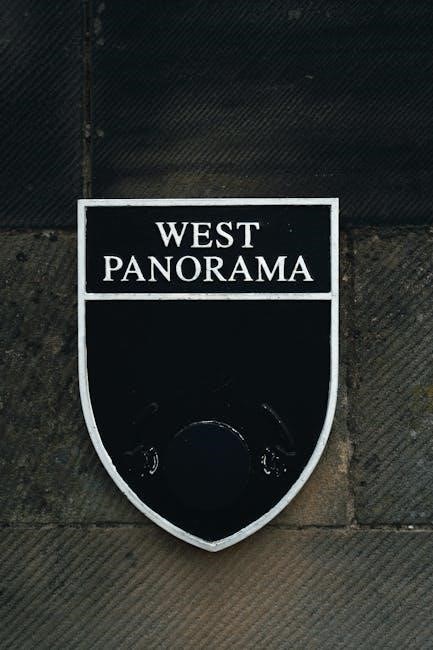The 1982 DC Comics Style Guide, created by José Luis García-López, standardized character designs to ensure consistency across DC’s superhero portrayals. Its 2023 reissue by Standards Manual highlights its enduring influence on visual storytelling.
1.1 Overview of the Style Guide
The 1982 DC Comics Style Guide was a comprehensive resource designed to standardize the visual representation of DC’s iconic superheroes. Created by José Luis García-López, it provided detailed illustrations and guidelines to ensure consistency in character designs across various media. The guide was essential for licensees, offering a unified look that maintained the integrity of DC’s intellectual property. Its reissue in 2023, published by Standards Manual, included original pages and additional content from 1982 to 1985, showcasing the evolution of DC’s visual identity. This document remains a cornerstone in comic book history, bridging the gap between artistic interpretation and brand continuity.
1.2 Importance of the Style Guide in DC Comics History
The 1982 DC Comics Style Guide is a landmark document in the history of DC Comics, serving as a foundational tool for maintaining visual consistency across its expansive universe. By standardizing character designs, it ensured that iconic heroes like Superman, Batman, and Wonder Woman were instantly recognizable in all forms of media and merchandise. This guide played a pivotal role in strengthening DC’s brand identity and licensing efforts, allowing for cohesive storytelling and marketing. Its influence extended beyond comics, shaping how DC’s characters were portrayed in animation, films, and other media. The guide’s reissue in 2023 underscores its enduring significance as a cornerstone of DC’s visual legacy and its continued relevance in modern storytelling.
Background and Creation of the 1982 Style Guide
The 1982 Style Guide emerged from DC Comics’ need for standardized visuals across its expanding universe, ensuring consistency in character designs and brand representation.
2.1 The Need for Standardization in DC Comics
By the early 1980s, DC Comics faced challenges with inconsistent character designs across various media, leading to confusion among fans and licensees. The lack of a unified visual approach affected merchandise, adaptations, and overall brand identity. This inconsistency hindered DC’s ability to maintain a cohesive look for iconic characters like Superman, Batman, and Wonder Woman. The need for standardization became critical to ensure that all representations of DC’s superheroes aligned with their core identities. This gap highlighted the necessity for a centralized guide to dictate how characters should appear, enabling better control over licensing and ensuring a consistent brand image across all platforms.
2.2 Key Figures Involved in the Creation
José Luis García-López was the primary creative force behind the 1982 DC Comics Style Guide, bringing his iconic artwork to define the visual standards for DC’s superheroes. Collaborating closely with DC Comics’ editorial and design teams, García-López ensured the guide reflected the essence of each character. The project also involved key decision-makers at DC Comics, who recognized the need for a unified visual identity. Additionally, the reissue of the guide in 2023 was spearheaded by Standards Manual, with Hamish Smyth and Jesse Reed playing pivotal roles in preserving and enhancing the original work for modern audiences.
2.3 The Role of José Luis García-López
José Luis García-López was the visionary artist behind the 1982 DC Comics Style Guide, creating iconic, detailed illustrations that defined the visual identity of DC’s superheroes. His work provided a consistent reference for character designs, ensuring uniformity across all DC Comics publications and merchandise. García-López’s art became the benchmark for how characters like Superman, Batman, and Wonder Woman should be depicted, balancing both classic and modern elements. His contributions were instrumental in establishing a cohesive visual language for DC Comics, making him a cornerstone of the Style Guide’s creation and legacy. The 2023 reissue of the guide further celebrated his enduring impact on DC’s visual storytelling.

The Reissue of the 1982 Style Guide in 2023
The 2023 reissue, published by Standards Manual, features the original 1982 guide plus additional pages from 1982 to 1985, showcasing José Luis García-López’s iconic artwork and design.
3.1 Details of the Reissue
The 2023 reissue of the 1982 DC Comics Style Guide, published by Standards Manual, faithfully reproduces the original while adding previously unseen content. Based on the original copy held by Standards Manual, the reissue includes pages added by the guide’s owners between 1982 and 1985. It features iconic artwork by José Luis García-López, showcasing his meticulous designs for DC superheroes. The reissue is presented as a high-quality, cloth-bound collector’s edition, appealing to both longtime fans and new enthusiasts. This updated versions the guide’s historical significance while introducing it to a modern audience, emphasizing its importance in shaping DC’s visual identity.
3.2 Enhancements and Additions in the Reissue
The 2023 reissue of the 1982 DC Comics Style Guide includes enhanced high-resolution scans of José Luis García-López’s artwork, ensuring crisp and detailed visuals. Additional content, such as historical context and commentary, provides deeper insight into the guide’s creation and significance. The reissue also features previously unpublished material, offering fans a more comprehensive look at DC’s iconic characters. Design elements, including spot varnishes and a cloth-bound cover, elevate the edition’s collectibility. A foreword by designer Michael Garland further enriches the publication, highlighting its importance in comic book history. These enhancements make the reissue a must-have for both collectors and new generations of DC enthusiasts, bridging the gap between nostalgia and modern appreciation.
3.3 Reception of the Reissue by Fans and Collectors
The 2023 reissue of the 1982 DC Comics Style Guide has been met with widespread enthusiasm from fans and collectors. Many have praised the meticulous attention to detail and the high-quality presentation of José Luis García-López’s iconic artwork. Collectors appreciate the additional historical context and unpublished material, which offers a deeper understanding of DC’s visual legacy. The reissue has also sparked nostalgia among long-time fans, who cherish the opportunity to revisit the foundational designs of their favorite characters. Overall, the reissue has been celebrated as a must-have collector’s item, bridging the gap between retro nostalgia and contemporary appreciation for DC Comics’ rich history and artistic excellence.

The Artwork and Design of the Style Guide
José Luis García-López’s iconic artwork defined the guide, showcasing standardized character designs that ensured consistency and recognition, leaving a lasting impact on DC’s visual identity and brand continuity.
4.1 The Iconic Artwork by José Luis García-López
José Luis García-López’s artwork in the 1982 DC Comics Style Guide is renowned for its clarity and precision. His illustrations set the standard for how DC superheroes should look, blending dynamic poses with clean, recognizable designs. García-López’s work became the benchmark for licensing and merchandise, ensuring consistency across all mediums. His art showcased iconic characters like Superman, Batman, and Wonder Woman in a way that balanced classic traits with modern appeal. The reissued guide highlights his contributions, offering fans a glimpse into his meticulous process and the enduring legacy of his visuals in shaping DC’s visual identity. His influence remains a cornerstone of the DC Universe’s aesthetic.
4.2 Design Elements and Character Consistency
The 1982 DC Comics Style Guide emphasized precise design elements to ensure character consistency. It detailed proportions, costume details, and logo placements, providing a unified visual language. This ensured that DC superheroes like Superman, Batman, and Wonder Woman looked identical across comics, merchandise, and other media. The guide included reference artwork and specifications for anatomy, facial expressions, and iconic accessories. These guidelines were crucial for licensees to maintain brand integrity. By standardizing these elements, DC Comics strengthened its visual identity, making its characters instantly recognizable. The guide’s focus on consistency helped build a cohesive universe, reinforcing DC’s legacy as a leader in comic book storytelling and licensing. This approach remains influential in modern character design.
4.3 The Use of Color and Composition
The 1982 DC Comics Style Guide meticulously addressed the use of color and composition to enhance character recognition and storytelling. It specified a vibrant yet consistent palette for each hero, ensuring their iconic looks remained unchanged. Composition guidelines focused on dynamic poses and balanced layouts, making characters stand out. The guide emphasized proper lighting and shading techniques to add depth and energy. These visual standards ensured that DC’s superheroes maintained a cohesive and recognizable appearance across all media. By balancing artistic expression with consistency, the Style Guide helped solidify DC’s visual identity, making its characters unforgettable and its brand identity robust. This attention to detail remains a cornerstone of DC’s success in licensing and merchandise.
The Purpose and Goals of the Style Guide
The 1982 DC Comics Style Guide aimed to standardize character designs, ensure consistency across media, and maintain brand identity. Its 2023 reissue underscores its lasting impact.
5.1 Standardizing the Look of DC Superheroes
The 1982 DC Comics Style Guide played a pivotal role in unifying the visual representation of iconic characters like Superman, Batman, and Wonder Woman. By providing precise illustrations and design specifications, it ensured consistency in how these heroes were depicted across various mediums. This standardization was crucial for maintaining brand recognition and coherence, especially as DC expanded its licensing efforts. The guide emphasized uniformity in character proportions, costumes, and facial features, creating a cohesive visual identity for the DC Universe. This approach not only streamlined creative processes but also strengthened the emotional connection fans had with these legendary characters, solidifying their place in popular culture. The guide’s impact remains evident in modern character designs, showcasing its lasting influence on DC’s visual legacy.
5.2 Ensuring Consistency Across Licensing
The 1982 DC Comics Style Guide was instrumental in maintaining a cohesive visual identity across all licensed products. By providing detailed character models and design specifications, it ensured that Superman, Batman, and other iconic heroes looked the same whether they appeared on toys, apparel, or other merchandise. This consistency helped licensees avoid design discrepancies, preserving the integrity of DC’s brand. The guide became a cornerstone for merchandising, enabling partners to accurately represent DC’s characters. Its standardized approach not only streamlined production but also reinforced fan recognition, making it a vital tool for expanding DC’s reach into new markets while maintaining a unified brand image globally.
5.3 Maintaining the Brand Identity of DC Comics
The 1982 DC Comics Style Guide played a pivotal role in safeguarding the brand identity of DC Comics. By establishing clear visual standards, it ensured that characters like Superman, Batman, and Wonder Woman were consistently represented across various media. This uniformity reinforced DC’s recognizable and trusted brand image. The guide emphasized the importance of maintaining the iconic design elements of each character, from their costumes to their expressions, ensuring they remained true to their comic book origins. This meticulous approach not only preserved the legacy of DC’s characters but also strengthened their global recognition, solidifying DC’s position as a leader in the comic book industry and beyond.

The Impact of the Style Guide on Licensing
The 1982 DC Comics Style Guide became a crucial tool for licensees, ensuring consistent character designs across merchandise. It streamlined branding, enabling uniform representation of DC’s iconic heroes.
6.1 How the Guide Influenced Merchandise
The 1982 DC Comics Style Guide played a pivotal role in shaping the visual consistency of merchandise. By providing standardized character designs, it ensured that toys, apparel, and other products featured accurate and recognizable depictions of DC superheroes. This uniformity enhanced brand recognition and appeal, making DC merchandise more cohesive and professional. The guide’s influence extended beyond comics, impacting licensing partnerships and ensuring that fans could engage with their favorite characters in a consistent way across various platforms. Its reissue in 2023 further highlighted its enduring impact on merchandising strategies, solidifying its legacy as a foundational tool in DC’s visual identity.
6.2 The Role of the Guide in Brand Expansion
The 1982 DC Comics Style Guide significantly contributed to DC’s brand expansion by establishing a unified visual identity. Its standardized character designs ensured consistency across various media, enhancing DC’s global recognition. The guide’s reissue in 2023 by Standards Manual introduced it to new audiences, further amplifying its influence. This consistency enabled DC to expand into new markets and licensing opportunities, solidifying its presence in the entertainment industry. The guide’s role in maintaining a cohesive brand image has been crucial for DC’s growth, making it an essential tool in their strategic expansion efforts.
6.3 Case Studies of Successful Licensing
The 1982 DC Comics Style Guide played a pivotal role in successful licensing ventures, ensuring iconic characters like Superman, Batman, and Wonder Woman maintained consistent designs. One notable case is the 1989 Batman film, where the guide’s visuals influenced merchandise, creating a cohesive brand experience. Additionally, the guide supported the DC Animated Universe, ensuring characters like Batman and Superman had uniform appearances across TV shows and toys. Its reissue in 2023 further highlighted its impact, as modern licensing deals continue to benefit from the standardized designs. These case studies demonstrate how the guide bridged creative consistency with commercial success, solidifying DC’s status as a leader in entertainment licensing. Its influence remains evident in today’s licensing strategies, ensuring timeless appeal for DC’s iconic characters.

The Legacy of the 1982 Style Guide
The 1982 DC Comics Style Guide established visual consistency for iconic characters, influencing future designs. Its 2023 reissue by Standards Manual highlights its enduring impact on DC’s visual identity.
7.1 Its Influence on Modern Style Guides
The 1982 DC Comics Style Guide has become a benchmark for modern style guides, inspiring updated versions and influencing how character designs are standardized today. Its emphasis on consistency and visual coherence laid the groundwork for contemporary design approaches. The 2023 reissue introduced this foundational material to new generations, showcasing its timeless appeal. Many modern style guides now incorporate similar principles, such as uniform character proportions and detailed visual references. José Luis García-López’s iconic artwork remains a key inspiration, proving the guide’s enduring relevance in shaping visual identity across the comic book industry.
7.2 The Cultural Significance of the Guide
The 1982 DC Comics Style Guide holds profound cultural significance as a cornerstone of comic book history. It bridged the gap between comic storytelling and merchandise, ensuring iconic characters like Superman and Batman were recognizable worldwide. The guide’s reissue in 2023 reignited nostalgia for veteran fans while introducing its importance to new generations. Its meticulous attention to detail and artistic vision have made it a celebrated artifact in pop culture, symbolizing the evolution of superheroes from print to global phenomena. The guide’s influence extends beyond comics, shaping how visual identity is managed in entertainment, making it a timeless cultural treasure.
7.3 Its Role in Shaping DC Comics’ Visual Identity
The 1982 DC Comics Style Guide played a pivotal role in defining and unifying the visual identity of DC’s iconic characters. By providing standardized reference art, it ensured consistency in how superheroes like Superman, Batman, and Wonder Woman were depicted across various media. José Luis García-López’s detailed illustrations became the benchmark for character design, influencing both comic book art and merchandise. The guide’s reissue in 2023 further cemented its legacy, offering a glimpse into the foundational principles that shaped DC’s visual storytelling. Its impact remains evident in modern character designs, solidifying its importance as a cornerstone of DC Comics’ enduring visual identity.
The 1982 DC Comics Style Guide, reissued in 2023, remains a cornerstone of DC’s visual legacy, ensuring artistic consistency and timeless appeal for its iconic characters.
8.1 Summary of the Style Guide’s Importance
The 1982 DC Comics Style Guide, featuring José Luis García-López’s iconic artwork, stands as a cornerstone of DC’s visual identity. It standardized character designs, ensuring consistency across comic books, merchandise, and licensing. This guide not only streamlined DC’s branding but also became a vital resource for licensees, helping maintain the integrity of iconic superheroes. Its reissue in 2023 underscores its lasting influence, showcasing how it shaped the visual language of DC Comics. The guide’s impact on merchandise, brand expansion, and character recognition solidified its importance in comic book history, making it a timeless reference for fans and creators alike.
8.2 Final Thoughts on Its Enduring Legacy
The 1982 DC Comics Style Guide, helmed by José Luis García-López, leaves an indelible mark on comic book history. Its meticulous attention to detail and commitment to consistency have inspired modern style guides, ensuring DC’s visual identity remains cohesive. The guide’s influence extends beyond comics, shaping merchandise and licensing, and its 2023 reissue has introduced it to a new generation. Fans and collectors cherish it as both a historical artifact and a testament to the power of design in storytelling. García-López’s artwork continues to be celebrated, cementing the guide’s legacy as a foundational document in DC Comics’ enduring success and cultural impact.
